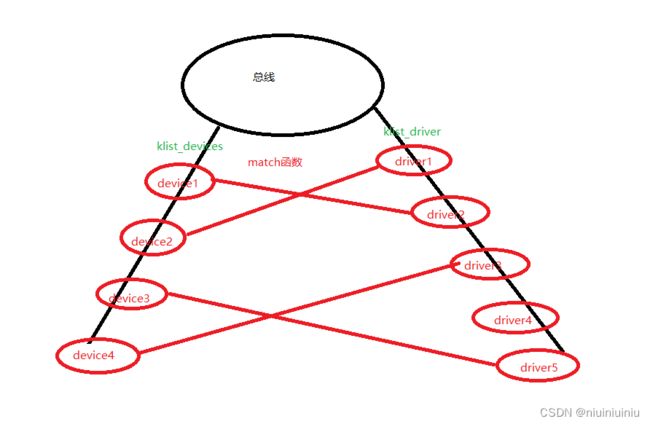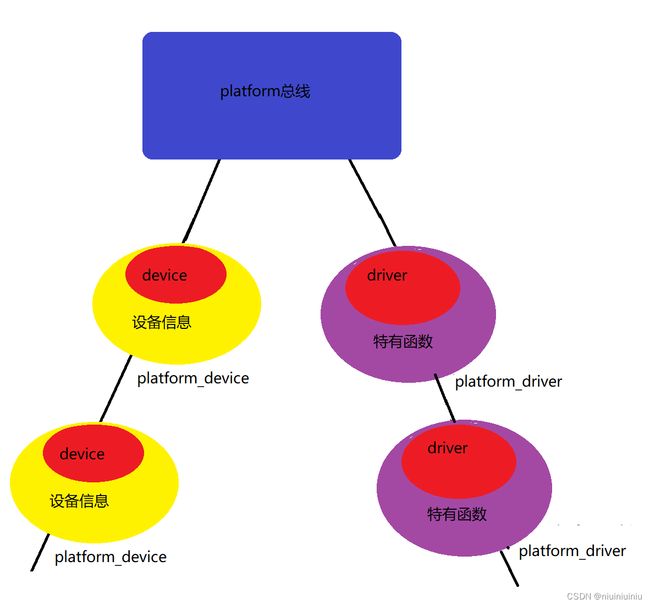Linux总线之Platform
文章目录
- 1.platform总线驱动
-
- 1.1设备模型的原理
- 1.2platform总线驱动的原理
- 1.3platform驱动的API
- 1.4platform按照名字匹配的实例
- 1.5驱动端获取设备信息的过程
- 1.6idtable的匹配方式
-
- 1.6.1为什么需要idtable匹配
- 1.6.2idtable匹配实例
- 1.6.3MODULE_DEVICE_TABLE宏的功能
- 1.7设备树匹配方式
-
- 1.7.1设备树中的设备信息的填写
- 1.7.2在驱动中填写设备树的匹配方式
- 1.7.3设备树匹配的实例
- 1.8platform总线驱动的练习
1.platform总线驱动
1.1设备模型的原理
在Linux内核中所有总线驱动都遵从设备驱动的模型,总线驱动的模型如下图:

内核在设计这些总线驱动模型的时候将一个驱动分为了三个部分device、bus、driver。
device是用来描述硬件设备的,bus是总线用来链接device和driver,driver是用来描述
驱动的对象。在内核中所有的device放在内核的klist_devices的链表中管理,而内核中
所有的driver放在klist_driver中管理。内核中的device和driver通过bus完成关联。
当device和driver匹配成功之后执行驱动的probe函数,在probe函数中就可以完成
操作硬件了。当卸载任何一方驱动的时候都会执行驱动中的remove函数。
1.2platform总线驱动的原理
platform总线驱动遵从设备模型,platform是Linux内核抽象出来的软件代码,并没
有真实的总线协议与之对应。platform总线驱动的思想就是要将设备信息和设备驱动
进行分离。platform_device和platform_driver通过总线匹配成功之后会执行驱动中
1.3platform驱动的API
设备端:
1.分配并初始化对象
struct platform_device {
const char *name; //用于匹配的名字
int id; //总线号 PLATFORM_DEVID_AUTO 自动分配总线号
struct device dev; //父类
u32 num_resources; //资源的个数
struct resource *resource; //资源的首地址
};
struct device { //父类
void (*release)(struct device *dev); //释放资源
}
struct resource { //设备信息结构体
resource_size_t start; //资源起始值 0x50006000 0xc0008000 71
resource_size_t end; //资源的结束值 0x50006000+3 0xc0008000+30 71
unsigned long flags; //资源的类型 IORESOURCE_IO IORESOURCE_MEM IORESOURCE_IRQ
};
2.注册、注销
platform_device_register(struct platform_device *); //注册
platform_device_unregister(struct platform_device *); //注销
驱动端:
1.分配并初始化对象
struct platform_driver {
int (*probe)(struct platform_device *);
//匹配成功执行的函数
int (*remove)(struct platform_device *);
//分离的时候执行的函数
struct device_driver driver;
//父类
const struct platform_device_id *id_table;
//2.idtable匹配
};
struct device_driver {
const char *name; //1.名字匹配
const struct of_device_id *of_match_table; //3.设备树匹配
}
2.注册、注销
platform_driver_register(drv); //注册
platform_driver_unregister(struct platform_driver *);//注销
3.驱动中一键注册注销的宏
module_platform_driver(__platform_driver)
module_driver(__platform_driver, platform_driver_register,platform_driver_unregister)
#define module_driver(pdrv, __register, __unregister, ...)
static int __init pdrv_init(void)
{
return platform_driver_register(&pdrv );
}
module_init(pdrv_init);
static void __exit pdrv_exit(void)
{
platform_driver_unregister(&pdrv);
}
module_exit(pdrv_exit);
1.4platform按照名字匹配的实例
pdev.c
#include pdrv.c
#include 1.5驱动端获取设备信息的过程
struct resource *platform_get_resource(struct platform_device *dev,
unsigned int type, unsigned int index)
功能:在设备驱动中获取设备信息的函数
参数:
@dev:设备端的结构体指针
@type:资源的类型
@index:同类型资源的编号
返回值:成功返回结构体指针,失败返回NULL
int platform_get_irq(struct platform_device *dev, unsigned int index)
功能:获取中断类型的资源
参数:
@dev:设备端的结构体指针
@index:中断类型资源的编号
返回值:成功返回中断号,失败返回错误码
pdrv.c
#include 1.6idtable的匹配方式
1.6.1为什么需要idtable匹配
内核中的驱动有的时候需要支持一系列设备,这一系列设备的名就可以放在idtable中。
不管用户使用的那个设备只要和idtable中的名字匹配成功都需要执行驱动中的probe函数。
如果驱动中写了idtable和name.先按照idtable匹配,如果匹配不上在按照name匹配。
name可以不用于匹配,但必须填充。
struct platform_device_id {
char name[PLATFORM_NAME_SIZE]; //名字
kernel_ulong_t driver_data; //给驱动传递的数据
};
struct platform_device_id idtable[] = {
{"hello0",0},
{"hello1",1},
{"hello2",2},
{"hello3",3},
{}, //如果前面的成员都没有匹配上从这里退出
};
struct platform_driver pdrv = {
.probe = pdrv_probe,
.remove = pdrv_remove,
.driver = {
.name = "hahahaha",
},
.id_table = idtable,
};
1.6.2idtable匹配实例
#include 1.6.3MODULE_DEVICE_TABLE宏的功能
MODULE_DEVICE_TABLE(总线类型, idtable数组名);
完成热插拔效果的宏
效果演示:
1.将pdev.ko 和pdrv.ko放到如下目录
/lib/modules/5.4.0-104-generic/kernel/drivers/platform
2.让系统重新扫描目录
sudo depmod -a
3.重启ubuntu系统
sudo reboot
1.7设备树匹配方式
在带设备树的内核版本中platform_device描述的设备信息都被放到了设备树中。
所以platform_device的驱动就不用写了。如果使用platform的设备树的匹配的方式,
只需要填写设备树,并编写platform_driver的代码即可。
1.7.1设备树中的设备信息的填写
myplatform{
compatible = "hqyj,myplatform"; //<====必须填充
reg = <0x12345678 0x31>;
interrupt-parent = <&gpiof>;
interrupts = <9 0>;
};
1.7.2在驱动中填写设备树的匹配方式
struct of_device_id {
char name[32];
char type[32];
char compatible[128]; //一般选择这种匹配方式
const void *data;
};
struct of_device_id oftable[] = {
{.compatible = "hqyj,myplatform",},
{} //不能省略
};
MODULE_DEVICE_TABLE(of, oftable);
struct platform_driver pdrv = {
.probe = pdrv_probe,
.remove = pdrv_remove,
.driver = {
.name = "hahahaha",
.of_match_table = oftable,
},
};
1.7.3设备树匹配的实例
#include 1.8platform总线驱动的练习
1.基于platform驱动实现如下要求 //platform总线驱动
a.应用程序通过阻塞的io模型来读取status变量的值 //等待队列
b.status是内核驱动中的一个变量,代表LED1的状态
c.status的值随着按键按下而改变(按键中断) //按键中断
例如status=0 按下按键status=1 ,再次按下按键status=0
d.在按下按键的时候需要同时将led1的状态取反 //gpio子系统
e.驱动中需要编写字符设备驱动 //字符设备驱动
f.驱动中需要自动创建设备节点 //自动创建设备节点
g.这个驱动需要的所有设备信息放在设备树的同一个节点中 //设备树
platform_irq_led.c
#include test.c
#include 
